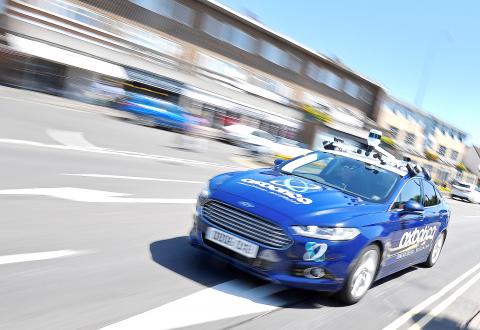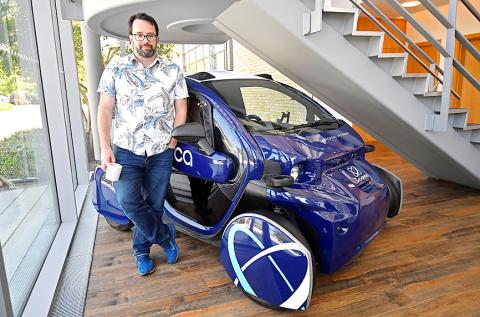Far from the sunny, wide streets of Phoenix, where Waymo’s self-driving taxis ply their trade, a handful of European start-ups are developing driverless vehicles to navigate the clogged, chaotic, rain-swept roads of European cities.
Start-ups, such as Oxbotica, FiveAI and Wayve, that are testing vehicles in Britain say the old continent is a unique proposition with quirks and challenges that tech giant Alphabet Inc’s Waymo, Uber Technologies Inc, Aurora and others have yet to crack.
Operating on a shoestring relative to their US rivals, the European start-ups say they have been forced to be creative and focus on cheaper, more tailored technologies that could cope in a heavy downpour on a busy London street.

Photo: Reuters
“A car trained to drive on the wide open highways of Arizona isn’t going to survive on the streets of Croydon. It’s a totally different environment,” said Alex van Someren, venture capital investor at Amadeus Capital Partners, which has a stake in FiveAI.
The start-ups hope that by developing systems and software that work in the most trying circumstances, they will be in a prime position when deep-pocketed US firms expand into new regions to capitalize on a future of self-driving vehicles.
According to the Boston Consulting Group (BCG), the era of connected high-tech vehicles is expected to generate about US$150 billion of new profits for the auto sector by 2035, making the race to nail the technology a potentially lucrative one.

Photo: Reuters
Some investors estimate one-fifth of global new vehicle sales will be self-driving vehicles by 2030.
While only a handful of start-ups are likely to survive, investors have poured US$70 billion of private investment since 2014 into more than 3,400 firms globally involved in “new mobility,” ranging from autonomous driving to ride hailing to electric scooters to machine learning, BCG says.
In the English university city of Oxford, Paul Newman cofounded robotics and self-driving company Oxbotica to develop “universal autonomy” software that could be sold to any automaker, fleet operator, delivery firm or transport company.
The company has been testing its software in a Ford Mondeo crowned with assorted cameras and sensors on the busy streets of the city, driving the same loop, down the high street and past the Red Lion pub, five times a day for three months.
Repeating different circuits over and over again with its fleet of vehicles gives the company a baseline to measure its progress, and in tricky areas it allows the software to come up with new data relevant to a specific place, Newman said.
“The negotiations one has to do with bicyclists and undergraduates in the early hours — around streets that frankly were designed for ponies — in these European cities is a little bit different,” he said.
The firm plans to open offices in North America and China, and aims to launch a self-driving taxi service in 2021 in London on specific routes — with a safety driver present — as part of a consortium working with cab company Addison Lee.
Oxbotica’s public road trials are labor-intensive and costly, and demonstrate the extent of the challenge facing companies aspiring to take on Waymo and Uber on a shoestring.
Like Wayve and FiveAI, Oxbotica is making do with a fraction of the funding doled out in the US to futuristic transport companies. It has received funding of £22.6 million (US$28.4 million), while FiveAI has raised US$37.7 million, data from Crunchbase showed.
By way of comparison, General Motors Co’s self-driving division Cruise raised US$1.15 billion in new equity in May, valuing the unit at US$19 billion, while California-based driverless delivery start-up Nuro raised US$940 million in February.
The amount of venture capital funding going into autonomous vehicle and tech companies in Europe doubled last year, but was still a tiny fraction of the amount pumped into US start-ups. The European firms pulled in US$89 million last year, just 2 percent of the venture capital funding collected by US companies, data from CB Insights showed.
US start-ups might benefit from generous funding, but Europeans argue the yawning gap in financing — coupled with the particular regional needs — has pushed them to find cheaper ways to plug the technological gaps.
Lidar, for example, the laser pulse technology used widely in US autonomous vehicles, struggles to paint an accurate picture of a vehicle’s surroundings once rain, fog or snow set in, so developers in Europe are testing a range of other tools.
“The challenges we have to solve here are subtly different and that calls for a different set of sensors ... and more emphasis on image and video processing, use of visual techniques for localization,” FiveAI founder and CEO Stan Boland said. “The deterioration of lidar in the rain is pretty horrendous.”
FiveAI started road tests in the London boroughs of Bromley and Croydon this year and hopes to launch passenger trials next eyar.
Its long-term objective is to operate an autonomous vehicle fleet that would complement public transport.
While Oxbotica’s Newman and Boland argue that lidar has a role to play — alongside other sensors and cameras — Wayve, an autonomous driving company based in the university city of Cambridge, says that the laser technology is unnecessary.
Wayve cofounder Amar Shah said that recent improvements mean you can now obtain reliable relative depth estimates using cameras alone, and that would be far cheaper and more reliable when it comes to mass producing self-driving vehicles.
Wayve would be looking for partnerships in the near future with vehicle makers, suppliers and any other bodies such as regulators involved in developing a driverless future, he said.
He also shrugged off the idea companies such as Waymo and Cruise would pose a serious threat with their bigger financial clout.
“They’ve spent 10 years in Phoenix, Arizona and can barely get out of there, so how can they come to Europe?” Shah said.
Nevertheless, analysts and consultants paint a future dominated by companies such as Uber and Waymo with massive fleets offering cheap monthly subscriptions for on-demand, self-driving vehicles, but full autonomy could still be years away.
“From the first idea that this will happen fairly quickly, now the autonomy winter has come,” said Arthur Kipferler, partner at automotive consultancy Berylls Strategy Advisors.
The challenges the technology faces were highlighted when a pedestrian was killed in March last year by a self-driving vehicle being tested by Uber. The incident caused a temporary halt to Uber’s development program.
“When you get on the ground and you go on a test drive in autonomous vehicles, whether it’s in San Francisco or in China, in unfamiliar, complex urban environments, they’re still a ways off in terms of getting to full autonomy,” said Deborah Orida, global head of active equities at Canada Pension Plan Investment Board, which has invested in self-driving start-ups Aurora and Zoox.
For European start-ups, wariness on the part of investors about promises of one-size-fits-all autonomy could be an opportunity to sell their message.
Yet, while they might see self-driving as a fundamentally regional challenge, others are critical of their localized approach, saying the US giants will win out by ensuring commercially viable services first.
“If you want a business, I think you need to go where it’s easier, do it fairly quickly and then scale up, learn, and go to the next level of difficulty,” Kipferler said. “If you’re in it for the research side then test it in central London or Mumbai or Delhi — and you will never have a commercial service, but you will have the research.”

SEEKING CLARITY: Washington should not adopt measures that create uncertainties for ‘existing semiconductor investments,’ TSMC said referring to its US$165 billion in the US Taiwan Semiconductor Manufacturing Co (TSMC, 台積電) told the US that any future tariffs on Taiwanese semiconductors could reduce demand for chips and derail its pledge to increase its investment in Arizona. “New import restrictions could jeopardize current US leadership in the competitive technology industry and create uncertainties for many committed semiconductor capital projects in the US, including TSMC Arizona’s significant investment plan in Phoenix,” the chipmaker wrote in a letter to the US Department of Commerce. TSMC issued the warning in response to a solicitation for comments by the department on a possible tariff on semiconductor imports by US President Donald Trump’s

The government has launched a three-pronged strategy to attract local and international talent, aiming to position Taiwan as a new global hub following Nvidia Corp’s announcement that it has chosen Taipei as the site of its Taiwan headquarters. Nvidia cofounder and CEO Jensen Huang (黃仁勳) on Monday last week announced during his keynote speech at the Computex trade show in Taipei that the Nvidia Constellation, the company’s planned Taiwan headquarters, would be located in the Beitou-Shilin Technology Park (北投士林科技園區) in Taipei. Huang’s decision to establish a base in Taiwan is “primarily due to Taiwan’s talent pool and its strength in the semiconductor

An earnings report from semiconductor giant and artificial intelligence (AI) bellwether Nvidia Corp takes center stage for Wall Street this week, as stocks hit a speed bump of worries over US federal deficits driving up Treasury yields. US equities pulled back last week after a torrid rally, as investors turned their attention to tax and spending legislation poised to swell the US government’s US$36 trillion in debt. Long-dated US Treasury yields rose amid the fiscal worries, with the 30-year yield topping 5 percent and hitting its highest level since late 2023. Stocks were dealt another blow on Friday when US President Donald

UNCERTAINTY: Investors remain worried that trade negotiations with Washington could go poorly, given Trump’s inconsistency on tariffs in his second term, experts said The consumer confidence index this month fell for a ninth consecutive month to its lowest level in 13 months, as global trade uncertainties and tariff risks cloud Taiwan’s economic outlook, a survey released yesterday by National Central University found. The biggest decline came from the timing for stock investments, which plunged 11.82 points to 26.82, underscoring bleak investor confidence, it said. “Although the TAIEX reclaimed the 21,000-point mark after the US and China agreed to bury the hatchet for 90 days, investors remain worried that the situation would turn sour later,” said Dachrahn Wu (吳大任), director of the university’s Research Center for